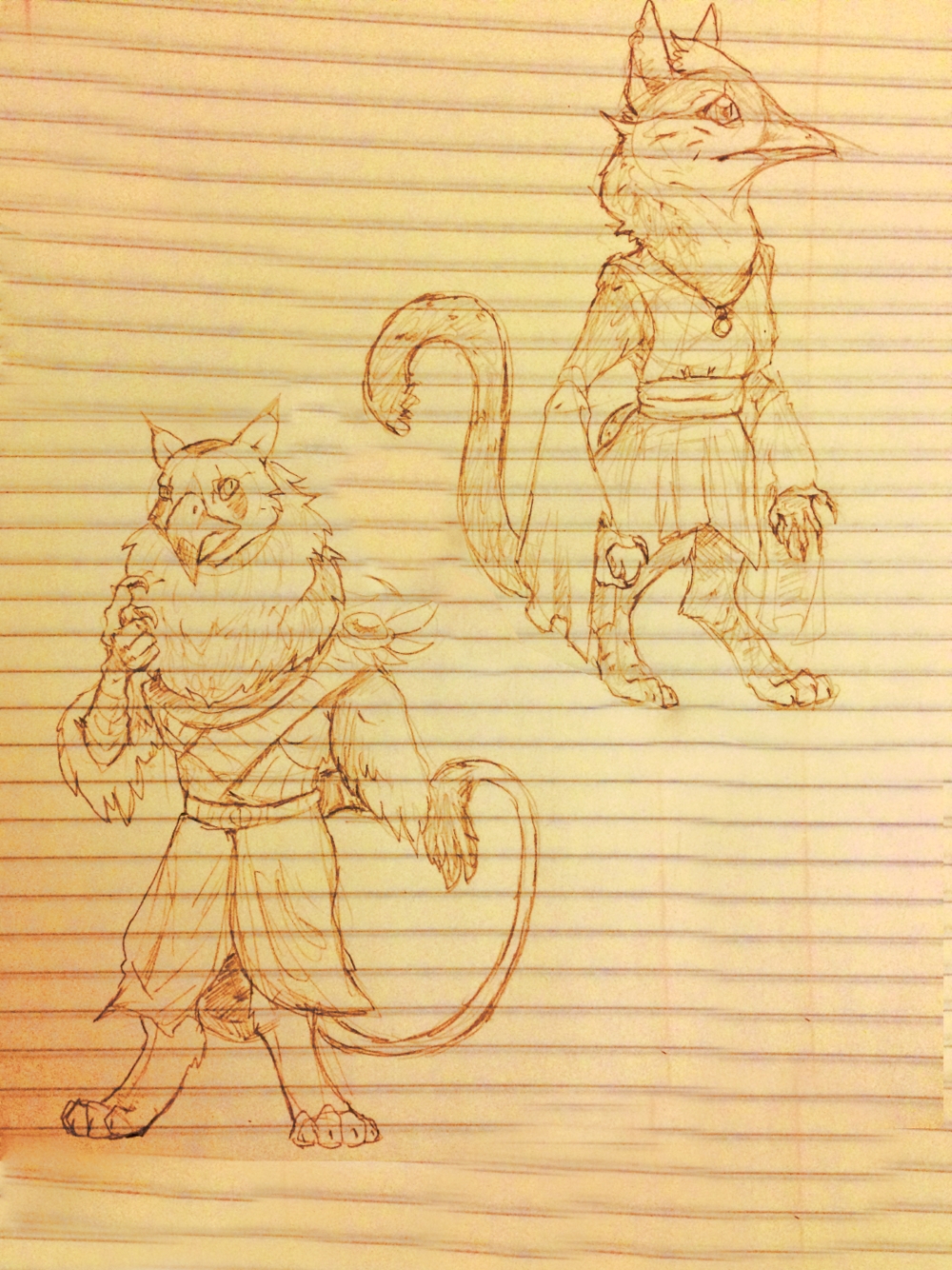Acquine
Acquine are diurnal hybrids between birds and felines. They are orderly creatures who are found in the Devan Over realm.
The acquine are a passionate and devoted, although organized, race who value aesthetics, and being righteous. Despite their close-mindedness (if not outright exclusiveness towards other cultures), many of them have expressed interest in learning about other peoples' customs in hopes of expanding their philosophy.
Basic Information
Anatomy
Acquine are hybridic in nature, so they share the same traits of the animals they are based on. Acquine are both bipedal and quadruped, although they prefer the former. The acquine have the traits of cats to complement their bird parts, which take up the upper half of the body. Their lower feline bodies are distinguished at the diaphragm; thus they lack mammaries to nurse their young.
The bird species the acquine take after favors various Accipitridae (excluding vultures), Passerida and fowl. As a result, the acquine tend to be more colorful than their sister race, and perhaps more diverse.
Despite this, feline teeth are also present inside the beak, although they’re long enough that they tend to stick out. Also, many acquine have different coat patterns based on the cat species; some have cheetah-like spots or tiger stripes across their body. Like cats, they have large ears and large eyes.
Biological Traits
The acquine have vestigial nubs and feathers on their back, due to the loss of wings.
Genetics and Reproduction
Acquine reproduce viviparously, and can give birth to 3-5 newborns per pregnancy. An individual acquine can only be a combination of one feline and one avian species. Inheritance of the species is at random, but an individual inherits only one species from each parant regardless of the parents' sex. For instance, a male hawk-leopard and a female falcon-lion may have hawk-lion offspring. In rarer cases, the individual may have the same species combination as one of the parents.
Growth Rate & Stages
Growth is at a negative leap year - time moves at a different scale in Deva, and acquine grow half the rate as humans in terms of chronology. When born, acquine are infant cubs distinguished by they chubby, quadruped body and beaks. However, the infants will grow quickly from this stage and reach the equivalent of a human one-year old. In the time between infant and juvenile, the acquine learns to become bipedal and start wearing clothing. It becomes a juvenile when it is chronologically three years old; this is the only time when it and a human's ages are identical. Afterwards, the acquine's growth rate and maturation becomes half the length of a human's, so two chronological years for a human will be only one year for acquine. Juveniles take eleven acquine years to grow; afterwards, they enter their adolescent phase at the acquine age of fifteen, where the males develop visible plumage. By the time they are twenty-three, the acquine has reached their natural height and maturation. At age thirty-two they enter their adult phase.
Ecology and Habitats
Their native habitat is a tropical, sunny oasis-like environment based on Egyptian and Grecian architecture.
Dietary Needs and Habits
Due to being felid, acquine are predominantly carnivores; but there may be some omnivorous members based on the bird variety. To survive, they feast on smaller animals by hunting and trapping the wildlife, although they give their prey a quick death.
Additional Information
Facial characteristics
Some acquine have crests in the form of plumage and fur around their neck, this is a trait more common in males. Size difference is negligible, as there are many females and males of the same sizes.
Perception and Sensory Capabilities
Acquine can manipulate light energy. Similar to cats, they have excellent vision and hearing. Acquine are not hindered by light; they thrive in it, and can see even in bright light. However, this has evolved to the point of dependency, as sun deprivation will severely weaken the acquine and risk biological degeneration.
Civilization and Culture
Naming Traditions
Males have the first or second syllable of their name given as "-iel" or "el", or at least sounds similar to those.
Females have the vowel "a" in the beginning or ending syllable; the pronounciation can be either "ah" or "uh".
Average Technological Level
Acquine technology is Grecian-like, relying on metals and substances such as marble and gold to form their buildings and tools. Their homes are mostly made of lightweight marble but covered with drapes to let sunlight in.
Common Dress Code
Acquine, due to their warm environment, don't wear too much clothing, exposing their animalistic heads. They tend to wear scarves, shoulder pads, and baggy pants, and sometimes transparent shawls. They are concerned about the quality of life, as such they wear richly-decorated clothing that covers the essentials and a lot of jewelry. The more refined acquine are observed wearing medals and clasps decorated with feathers.
Common Myths and Legends
The acquine worship the Devan god of light and rebirth, Arael. Arael is the progenitor of the acquine race, thus the acquine worship it out of respect. The acquine place high importance on righteousness and purity, so they naturally see their god as the purest and greatest out of the other gods, and fail to understand why other races don't share this sentiment. The god of light provides to the acquine sunlight, food, and resources by means of the fertile land that they occupy.
Interspecies Relations and Assumptions
The acquine's counterparts are the corvine. In many ways, they are opposites - whereas corvine civilization revolves around the nature of darkness, the acquine revolve around the nature of light. Neither race can interbreed with each other.
Lifespan
180 years
Average Height
4-7 ft
Body Tint, Colouring and Marking
Males and females can be distinguished purely by plumage and color. Females tend to have muted tones for their coloring, while males can be found in a broad spectrum of colors, from blue to pink to gold.
Remove these ads. Join the Worldbuilders Guild









Comments